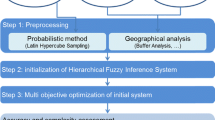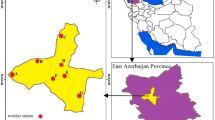Abstract
The significant volume of vehicular traffic has been considered one of the main causes of air pollution due to the rapid growth of urbanization and motorization in the world. This trend has instigated efforts to search for sustainable solutions aimed not only at mitigating the deleterious consequences stemming from air pollution but also at implementing efficacious urban mobility strategies and policies. In this context, the present study endeavors to explore the modeling and predicting of hospitalizations and associated costs linked to respiratory diseases, influenced by vehicular pollutants within the urban milieu of São Paulo—a city renowned for harboring one of the largest vehicular fleets globally. Specifically, an adaptive neuro-fuzzy inference system (ANFIS) was developed based on pollutant data encompassing carbon monoxide (CO), Particulate matter with diameters less than 10 µm (PM10), Particulate matter with diameters less than 2.5 µm (PM2.5), nitrogen dioxide (NO2), oone (O3), and sulfur dioxide (SO2), emitted within the city confines spanning the period from 2011 to 2019. The simulations conducted revealed that with knowledge of the monthly concentrations of the analyzed pollutants, it was feasible to forecast hospitalization rates and costs with an error lower than 6%. Additionally, scenarios illustrating the applicability of ANFIS in public health management and its contributions to the United Nations Sustainable Development Goals (SDGs) are presented and discussed.
Graphical abstract











Similar content being viewed by others
Data availability
No datasets were generated or analyzed during the current study.
References
Alexeeff SE, Roy A, Shan J, Ray GT, Quesenberry CQ, Apte J, Van Den Eeden SK (2022) Association between traffic related air pollution exposure and direct health care costs in Northern California. Atmos Environ 287:119271
Allegrini I, Ianniello A, Valentini F (2023) Environmental air pollution: An anthropogenic or a natural issue?. In: Current trends and future developments on (bio-) membranes. Elsevier, pp 1–38
Amaral JL, Sancho AG, Faria AC, Lopes AJ, Melo PL (2020) Differential diagnosis of asthma and restrictive respiratory diseases by combining forced oscillation measurements, machine learning and neuro-fuzzy classifiers. Med Biol Eng Comput 58:2455–2473
Arbex MA, Santos UP, Martins LC, Saldiva PHN, Pereira LAA, Braga ALF (2012) Air pollution and the respiratory system. J Bras Pneumol 38(5):643–655
Bai X, Chen H, Oliver BG (2022) The health effects of traffic-related air pollution: a review focused the health effects of going green. Chemosphere 289:133082
Barthelemy J, Sanchez K, Miller MR, Khreis H (2020) New opportunities to mitigate the burden of disease caused by traffic related air pollution: antioxidant-rich diets and supplements. Int J Environ Res Public Health 17(2):630
Belan PA, de Macedo RAG, Alves WAL, Santana JCC, Araújo SA (2020) Machine vision system for quality inspection of beans. Int J Adv Manuf Technol 111:3421–3435
Berssaneti FT, Assumpção A, Nakao OS (2014) Engineering, procurement and construction (EPC): What are the variables that impact the success of the projects currently running in Brazil? Gestao e Producao 21(1):95–109. https://doi.org/10.1590/S0104-530X2014005000009
Bherwani H, Gautam S, Gupta A (2021) Qualitative and quantitative analyses of impact of COVID-19 on sustainable development goals (SDGs) in Indian subcontinent with a focus on air quality. Int J Environ Sci Technol 18:1019–1028
Canto MV, Guxens M, García-Altés A, López MJ, Marí-Dell’Olmo M, García-Pérez J, Ramis R (2023) Air Pollution and birth outcomes: health impact and economic value assessment in Spain. Int J Environ Res Public Health 20(3):2290
CETESB (2022) Environmental Sanitation Technology Company of São Paulo, Brazil. Air quality—Qualar. http://www.cetesb.gov.br. Accessed Apr 2023
Chang Q, Zhang H, Zhao Y (2020) Ambient air pollution and daily hospital admissions for respiratory system–related diseases in a heavy polluted city in Northeast China. Environ Sci Pollut Res 27:10055–10064
Chaves LE, Nascimento LFC, Rizol PMSR (2017) Fuzzy model to estimate the number of hospitalizations for asthma and pneumonia under the effects of air pollution. Rev Saude Publica. https://doi.org/10.1590/S1518-8787.2017051006501
Cintra M (2014) Os custos dos congestionamentos na cidade de São Paulo. Economy School of São Paulo, Getulio VargasFudaio, FGV-EESP, São Paulo
CONAMA, National Council of Environment. Políticas Ambientais. http://www.mma.gov.br/conama. Accessed Mar 2023
de Aguiar-Pontes-Pamplona Y, Arbex MA, Braga ALF, Pereira LAA, Martins LC (2020) Relationship between air pollution and hospitalizations for congestive heart failure in elderly people in the city of São Paulo. Environ Sci Pollut Res 27:18208–18220
De Marco A, Proietti C, Anav A, Ciancarella C, D’Elia I, Fares S, Fornasier MF, Fusaro L, Gualtieri M, Manes F, Marchetto A, Mircea M, Paoletti E, Piersanti A, Rogora M, Salvati L, Salvatori E, Screpanti A, Vialetto G, Vitale M, Leonardi C (2019) Impacts of air pollution on human and ecosystem health, and implications for the National Emission Ceilings Directive: insights from Italy. Environ Int 125:320–333
Gao J, Kovats S, Vardoulakis S, Wilkinson P, Woodward A, Li J, Gu S, Liu X, Wu H, Wang J, Song X, Zhai Y, Zhao J, Liu Q (2018) Public health co-benefits of greenhouse gas emissions reduction: a systematic review. Sci Total Environ 627:388–402
Gurram S, Stuart AL, Pinjari AR (2019) Agent-based modeling to estimate exposures to urban air pollution from transportation: exposure disparities and impacts of high-resolution data. Comput Environ Urban Syst 75:22–34
Jang JS (1993) ANFIS: adaptive-network-based fuzzy inference system. IEEE Trans Syst Man Cybern 23(3):665–685
Kapoor NR, Kumar A, Kumar A, Kumar A, Arora HC, Jahangir H (2023) Prediction of indoor air quality using artificial intelligence. In: Machine Intelligence, Big Data Analytics, and IoT in Image Processing
Katushabe C, Kumaran S, Masabo E (2021) Fuzzy based prediction model for air quality monitoring for Kampala City in East Africa. Appl Syst Innov 4(3):44
Kunzli N, Perez L, Rapp R (2010) Air quality and health. Lausanne: European Respiratory Society, 66. ISBN 978-1-84984-008-8
Leirião L, de Oliveira M, Martins T, Miraglia S (2023) A multi-pollutant and meteorological analysis of cardiorespiratory mortality among the elderly in São Paulo, Brazil—an artificial neural networks approach. Int J Environ Res Public Health 20:5458
Liao L, Du M, Chen Z (2021) Air pollution, health care use and medical costs: evidence from China. Energy Econ 95:105132
Librantz AF, de Araújo SA, Alves WA, Belan PA, Mesquita RA, Selvatici AH (2017) Artificial intelligence based system to improve the inspection of plastic mould surfaces. J Intell Manuf 28:181–190
Mata TM, Felgueiras F, Martins AA, Monteiro H, Ferraz MP, Oliveira GM, Silva GV (2022) Indoor air quality in elderly centers: pollutants emission and health effects. Environments 9(7):86
Miranda RM, Lopes F, Rosario NE, Yamasoe MA, Landulfo E, Andrade MF (2017) The relationship between aerosol particles chemical composition and optical properties to identify the biomass burning contribution to fine particles concentration: a case study for Sao Paulo City, Brazil. Environ Monit Assess 189:1060–1066
Miranda AC, Santana JCC, Yamamura CLK, Rosa JM, Tambourgi EB, Ho LL, Berssaneti FT (2021) Application of neural network to simulate the behavior of hospitalizations and their costs under the effects of various polluting gases in the city of São Paulo. Air Qual Atmos Health 1–9
Ren Z, Ji X (2023) On prediction of air pollutants with Takagi-Sugeno models based on a hierarchical clustering identification method. Atmos Pollut Res 14(4):101731
Rosa JM, Prado KRM, Alves WAL, Pereira FH, Santana JCC, Tambourgi EB (2013) Applying of a neural network in effluent treatment simulation as an environmental solution for textile industry. Chem Eng Trans 32:73–78. https://doi.org/10.3303/CET1332013
Rosa JM, Guerhardt F, Ribeiro Júnior SER, Belan PA, Lima GA, Santana JCC, Araújo SAD (2021) Modeling and optimization of reactive cotton dyeing using response surface methodology combined with artificial neural network and particle swarm techniques. Clean Technol Environ Policy 23:2357–2367
Santana JCC, Miranda AC, Yamamura CLK, Silva Filho SCD, Tambourgi EB, Lee Ho L, Berssaneti FT (2020) Effects of air pollution on human health and costs: current situation in São Paulo, Brazil. Sustainability 12(12):4875
Santana JCC, Araújo SA, Biazus JPM, Souza RR (2015) Simulation of biodegradation process of wastewater from meat industry by means of a multilayer perceptron artificial neural network. Ingeniare Rev Chilena Ingeniería 23:269–275
Santos UP, Braga ALF, Garcia MLB, Pereira LAA, Lin CA, Chiarelli PA, de André CAS, de André PA, Singer JM, Saldiva PHN (2019) Exposure to fine particles increases blood pressure of hypertensive outdoor workers: a panel study. Environ Res 174:88–94
Saut AM, Berssaneti FT, Moreno MC (2017) Evaluating the impact of accreditation on Brazilian health care organizations: a quantitative study. Int J Qual Health Care 29(5):713–721. https://doi.org/10.1093/intqhc/mzx094
Sicard P, Agathokleous E, Anenberg SC, De Marco A, Paoletti E, Calatayud V (2023) Trends in urban air pollution over the last two decades: a global perspective. Sci Total Environ 858:160064
Sistema Único De Saúde (SUS) (2023) Brazilian Health System. Data SUS. http://portalms.saude.gov.br/sistema-unico-de-saude. Accessed Nov 2019
Tainio M, Andersen ZJ, Nieuwenhuijsen MJ, Hu L, De Nazelle A, An R, de Sá TH (2021) Air pollution, physical activity and health: a mapping review of the evidence. Environ Int 147:105954
Tsai W-T, Lin Y-Q (2021) Trend analysis of air quality index (AQI) and greenhouse gas (GHG) emissions in Taiwan and their regulatory countermeasures. Environments 8:29
Vieira LCPFDS, Rizol PMDSR, Nascimento LFC (2019) Fuzzy logic and hospital admission due to respiratory diseases using estimated values by mathematical model. Cien Saude Colet 24:1083–1090
World Health Organization (WHO) (2023) Air pollution. https://www.who.int/health-topics/air-pollution#tab=tab_1. Accessed Apr 2023
Xu D, Ge B, Chen X, Sun Y, Cheng N, Li M, Pan X, Ma Z, Pan Y, Wang Z (2019) Multimethod determination of the below-cloud wet scavenging coefficients of aerosols in Beijing. China Atmos Chem Phys 19:15569–15581. https://doi.org/10.5194/acp-19-15569-2019
Yu T, Wang W, Ciren P, Zhu Y (2016) Assessment of human health impact from exposure to multiple air pollutants in China based on satellite observations. Int J Appl Earth Obs Geoinf 52:542–553
Zhao S, Yu Y, He J, Yin D, Wang B (2015) Below-cloud scavenging of aerosol particles by precipitation in a typical valley city, Northwestern China. Atmos Environ 102:70–78
Zhu X, Zhang Q, Du X, Jiang Y, Niu Y, Wei Y, Cai J (2023) Respiratory effects of traffic-related air pollution: a randomized, crossover analysis of lung function, airway metabolome, and biomarkers of airway injury. Environ Health Perspect 131(5):057002
Funding
The funding was provided by Coordenação de Aperfeiçoamento de Pessoal de Nível Superior.
Author information
Authors and Affiliations
Contributions
J.C.C.S., A.C.M., J.M.R., F.T.B., L.L.H., S.A.A. and P.A.B wrote the main manuscript text. L.L.S.F., .A.G., A.C.M. and J.M.R. collected and validated the data used in the experiments. L.L.S.F., .A.G., S.A.A., P.A.B perform the experiments. L.L.S.F. and .A.G. prepared all figures. All authors reviewed the manuscript.
Corresponding author
Ethics declarations
Conflict of interest
The authors declare no conflict of interest.
Additional information
Publisher's Note
Springer Nature remains neutral with regard to jurisdictional claims in published maps and institutional affiliations.
Rights and permissions
Springer Nature or its licensor (e.g. a society or other partner) holds exclusive rights to this article under a publishing agreement with the author(s) or other rightsholder(s); author self-archiving of the accepted manuscript version of this article is solely governed by the terms of such publishing agreement and applicable law.
About this article
Cite this article
Santana, J.C.C., Miranda, A.C., Rosa, J.M. et al. A neuro-fuzzy model to predict respiratory disease hospitalizations arising from the effects of traffic-related air pollution in São Paulo. Clean Techn Environ Policy (2024). https://doi.org/10.1007/s10098-024-02877-0
Received:
Accepted:
Published:
DOI: https://doi.org/10.1007/s10098-024-02877-0




